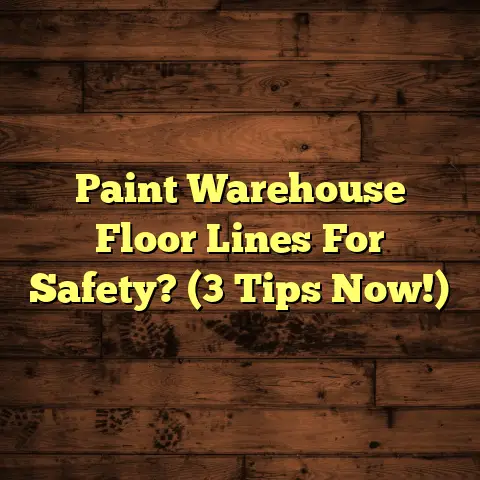Gym Flooring Over Carpet? (Read Before You Do!)
I’m seeing a huge trend lately: home gyms are popping up everywhere.
And honestly, I get it.
Who wouldn’t want a dedicated space to crush their fitness goals?
The COVID-19 pandemic really kicked this into high gear, with more and more people opting to create functional workout areas right in their homes.
As a flooring contractor who’s seen it all, I’m constantly getting asked about the best flooring solutions.
But one question keeps coming up: “Can I just put gym flooring over my existing carpet?”
Well, that’s exactly what we’re going to dive into today.
Is it a genius shortcut or a recipe for disaster?
We’ll explore the pros, the cons, and everything in between.
By the end of this article, you’ll know exactly what to do for your space.
Section 1: Understanding Gym Flooring Types
Okay, let’s get down to the nitty-gritty.
What are your options when it comes to gym flooring?
There’s a whole world beyond that old yoga mat!
Rubber Tiles: The workhorse of gym flooring.
Durable, shock-absorbent, and can handle some serious weight.Foam Mats: Think puzzle pieces for your floor.
Great for bodyweight exercises and creating a softer surface.-
Vinyl Sheets: A seamless option that’s easy to clean and offers good protection against weights.
-
Carpet Tiles: A popular choice because of its modular design and design flexibility.
Each of these has its own strengths and weaknesses, and the best choice for you really depends on what you’re planning to do in your gym.
Are you a heavy lifter? Rubber is your friend.
More into yoga and Pilates? Foam might be a better fit.
Here’s a quick rundown:
Choosing the right material is key.
You wouldn’t wear running shoes to a weightlifting competition, would you?
Same principle applies here.
Section 2: Pros and Cons of Installing Gym Flooring Over Carpet
Alright, let’s get to the heart of the matter: should you install gym flooring over carpet?
Here’s a balanced look at the good, the bad, and the potentially ugly.
Pros:
Convenience and Cost-Effectiveness: Let’s face it, ripping up carpet is a pain.
And it can get expensive!
Sticking gym flooring on top seems like a quick and easy fix.-
Additional Cushioning and Support: Carpet can add an extra layer of squish, which might feel nice for certain exercises.
-
Quick Installation: Slap it down and you’re done, right? In theory, yes.
Cons:
Moisture Retention and Mold Growth: This is a big one.
Carpet traps moisture, and that’s a breeding ground for mold and mildew.
Trust me, you don’t want that in your gym.Compromised Stability and Safety: Carpet isn’t a stable surface.
It can shift and move, especially under heavy weights.
This can lead to accidents and injuries.-
Difficulty in Cleaning and Maintaining Hygiene: Sweat, dirt, and grime can easily get trapped in the carpet fibers, making it difficult to keep your gym clean and hygienic.
Honestly, the cons often outweigh the pros in this situation.
While the idea of saving time and money is tempting, the potential risks to your health and safety are not worth it.
Section 3: The Impacts of Carpet on Gym Flooring Performance
Let’s dig a little deeper into how that carpet is actually messing with your gym flooring.
Texture and Pile Height: Think about it: a thick, plush carpet is going to feel a lot different under your gym flooring than a low-pile, commercial-grade carpet.
The texture and height affect how the gym flooring sits and performs.Stable, Flat Surface: Gym flooring needs a solid, even surface to do its job properly.
Carpet introduces inconsistencies and can create soft spots.-
Lifespan of Your Gym Flooring: All that shifting and unevenness caused by the carpet can put extra stress on your gym flooring, leading to premature wear and tear.
I’ve seen so many cases where people try to cut corners by laying gym flooring over carpet.
And trust me, it almost always ends up costing them more in the long run because they have to replace the flooring sooner than expected.
Here’s a table illustrating the impact:
Section 4: Assessing Your Current Carpet
Okay, so you’re still considering putting gym flooring over carpet.
I get it.
Let’s at least make sure you’re going in with your eyes open.
Here’s how to give your carpet a good once-over:
Signs of Wear and Damage: Look for stains, tears, rips, or areas where the carpet is matted down.
These are all red flags.Moisture Check: This is crucial.
Sniff around for musty odors, and check for any signs of water damage.
If you find any, you need to address the moisture issue before you even think about gym flooring.Firmness and Flatness Test: Walk around on the carpet.
Does it feel firm and stable?
Or does it feel spongy and uneven?
You want a surface that’s as flat and firm as possible.
If your carpet is old, worn, or shows any signs of moisture, it’s a no-go.
Seriously, just don’t do it.
You’re setting yourself up for problems down the road.
Section 5: Installation Process and Best Practices
Alright, if you’re absolutely determined to install gym flooring over carpet, let’s talk about how to do it (as safely and effectively as possible).
But remember, I’m still not recommending this!
- Preparation is Key: Vacuum the carpet thoroughly.
You want to remove as much dirt and debris as possible. - Surface Assessment: Double-check for any signs of moisture or unevenness.
Address any issues before moving on. - Alignment: Plan out your layout carefully.
Make sure your gym flooring is aligned properly and that you have enough material to cover the entire area. - Securing the Edges: Use a strong adhesive tape to secure the edges of the gym flooring to the carpet.
This will help prevent it from shifting and creating trip hazards. - Smooth Finish: Once everything is in place, walk around on the gym flooring to make sure it feels stable and even.
Tools and Materials:
- Vacuum Cleaner
- Measuring Tape
- Utility Knife
- Strong Adhesive Tape
Even with the best installation practices, you’re still dealing with the underlying issues of carpet.
Section 6: Alternatives to Installing Gym Flooring Over Carpet
Okay, let’s talk about some better options.
Because honestly, there are almost always better ways to get the gym flooring you want without the risks of putting it over carpet.
Remove the Carpet: This is the most straightforward solution.
Rip up the carpet, clean the subfloor, and install your gym flooring directly on top.
It’s more work upfront, but it’s worth it in the long run.Specialized Carpet Tiles: If you really want to keep the carpet feel, look into carpet tiles specifically designed for gym use.
These are typically low-pile, durable, and easy to clean.
Cost Implications:
-
Removing carpet can cost anywhere from \$1 to \$5 per square foot, depending on the complexity of the job.
-
Specialized carpet tiles can range from \$3 to \$10 per square foot.
While these options might seem more expensive upfront, they’ll save you money in the long run by preventing moisture issues, extending the lifespan of your gym flooring, and reducing the risk of injuries.
Section 7: Case Studies and Real-Life Experiences
Okay, I know I’ve been pretty negative about putting gym flooring over carpet.
But let’s hear from some real people who have actually tried it.
I’ve talked to a few folks who went this route, and their experiences are all over the map.
Case Study 1: The Budget-Conscious Beginner
- Scenario: A young professional wanted to set up a small home gym on a tight budget.
They decided to put foam mats over their existing carpet to save money on removal costs. - Outcome: Initially, they were happy with the extra cushioning.
However, after a few months, they started noticing a musty smell.
Upon lifting the mats, they discovered mold growing underneath. - Lesson Learned: Cutting corners can lead to bigger problems down the road.
- Scenario: A young professional wanted to set up a small home gym on a tight budget.
Case Study 2: The Experienced Lifter
- Scenario: A seasoned weightlifter tried putting rubber tiles over their low-pile carpet.
- Outcome: The carpet shifted and compressed under the weight, creating an unstable surface.
They quickly realized it was too dangerous to continue and ended up removing the carpet. - Lesson Learned: Stability is crucial for heavy lifting.
Carpet simply can’t provide the necessary support.
These are just a couple of examples, but they highlight the potential pitfalls of putting gym flooring over carpet.
Conclusion
Alright, we’ve covered a lot of ground today.
Let’s recap:
While the idea of installing gym flooring over carpet might seem appealing, it’s generally not a good idea.
The risks of moisture retention, mold growth, and compromised stability outweigh the convenience and cost savings.
Before you make any decisions, take a good hard look at your existing carpet, assess your workout needs, and consider the long-term implications.
Your safety and your investment are worth it.
Call to Action
So, what are your thoughts?
Have you ever tried putting gym flooring over carpet?
What was your experience?
Share your stories and questions in the comments below!
And if you’re still unsure about the best flooring solution for your gym, don’t hesitate to reach out to a professional for advice.





